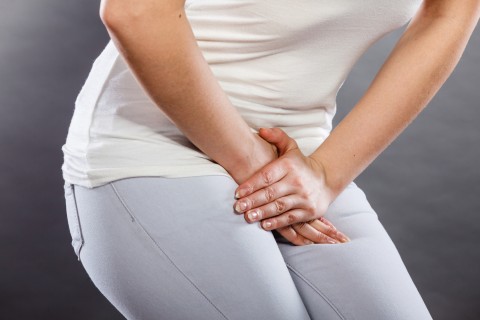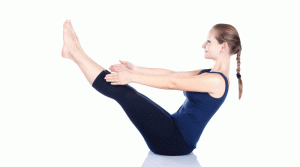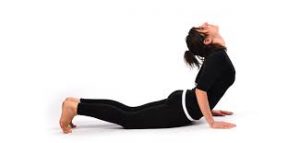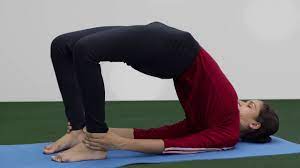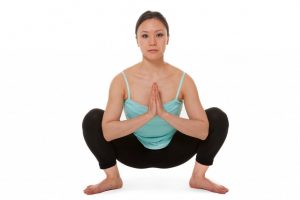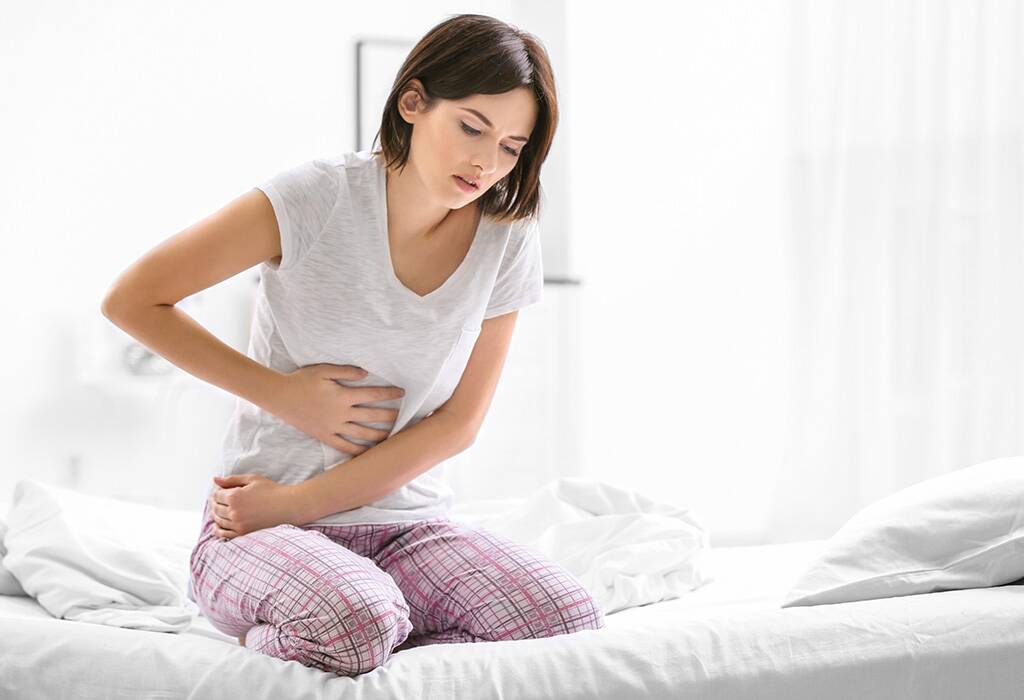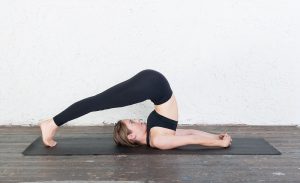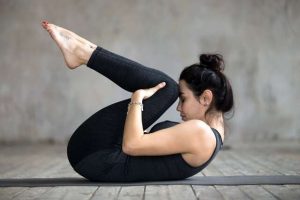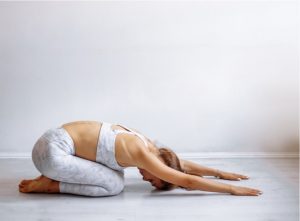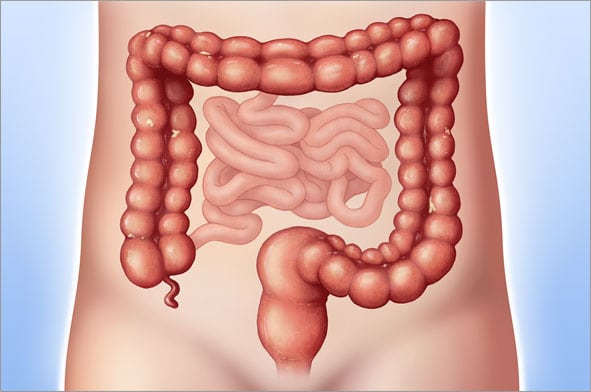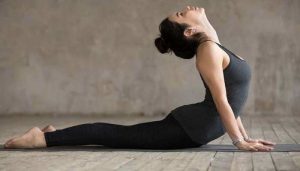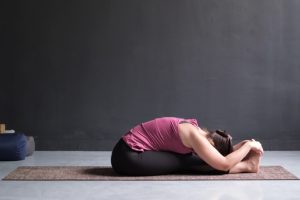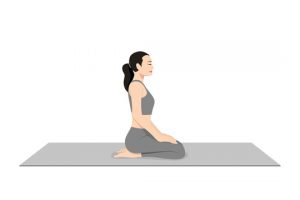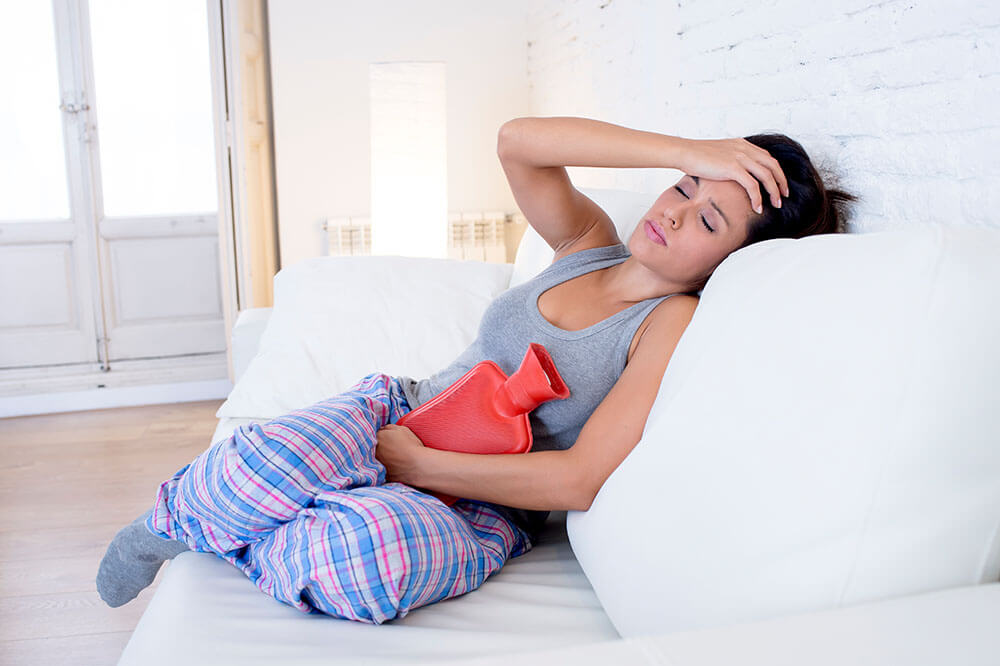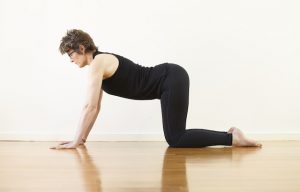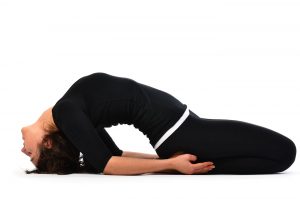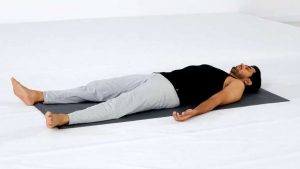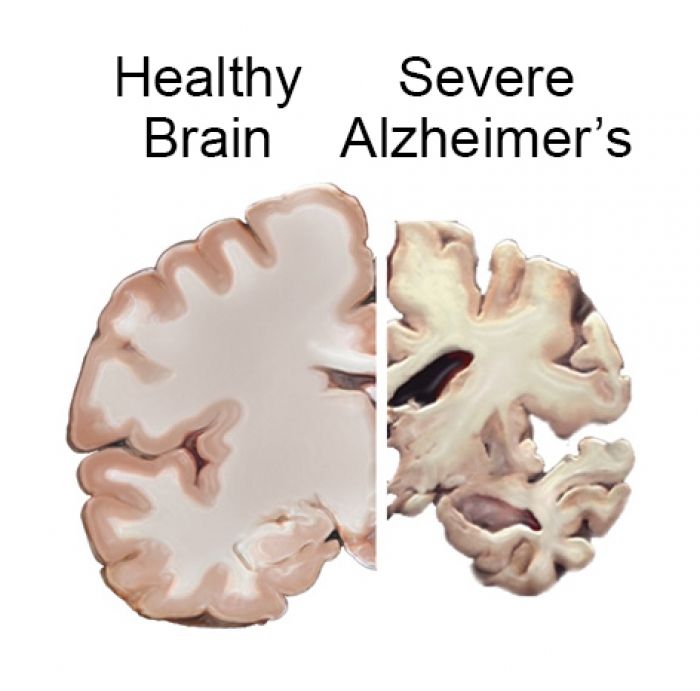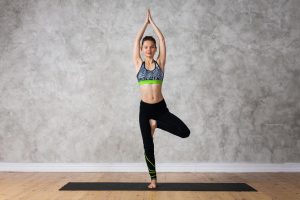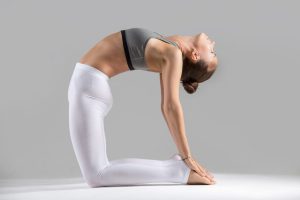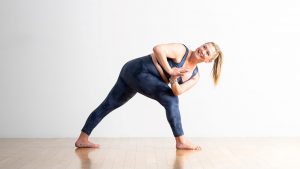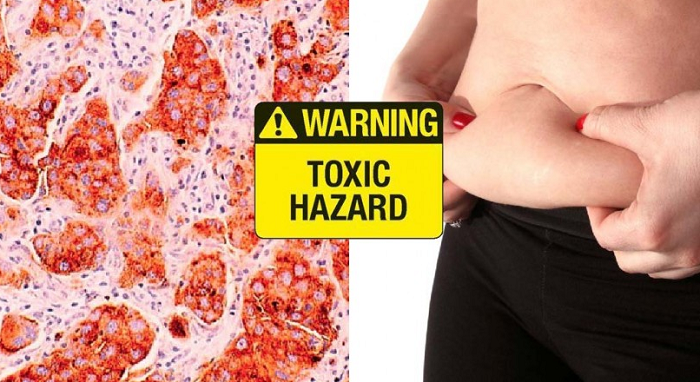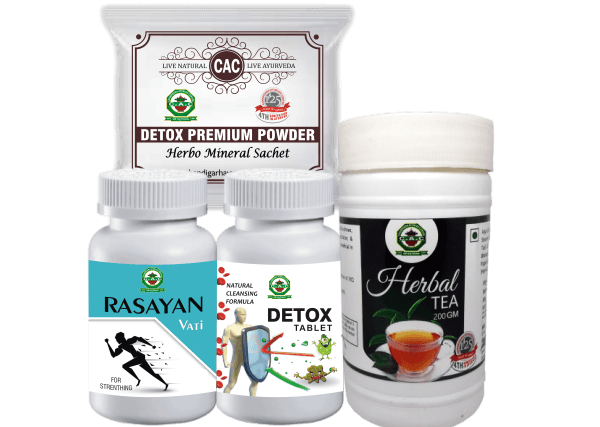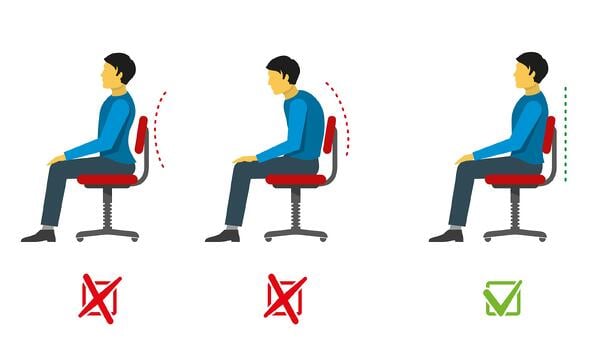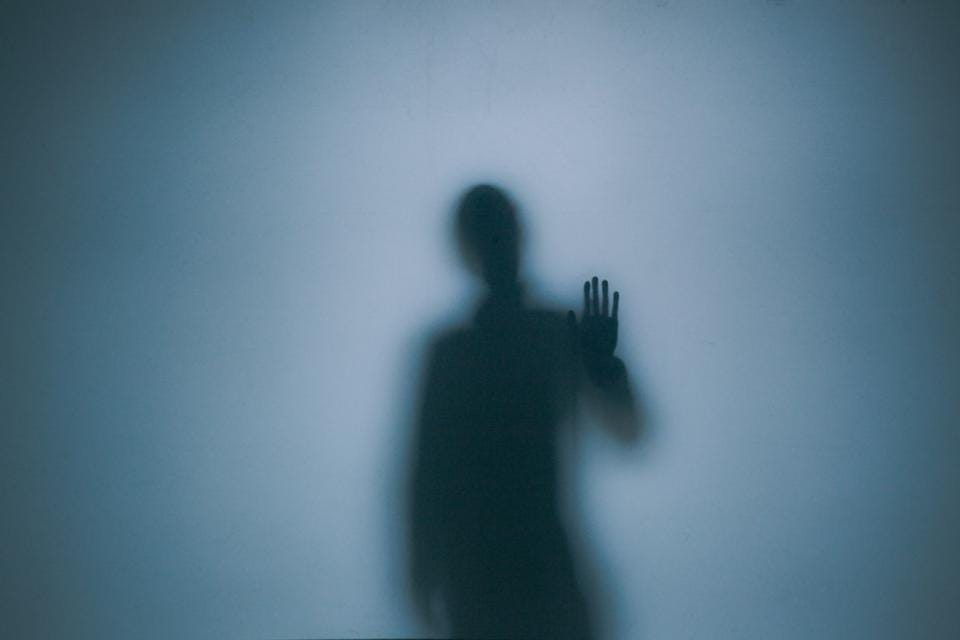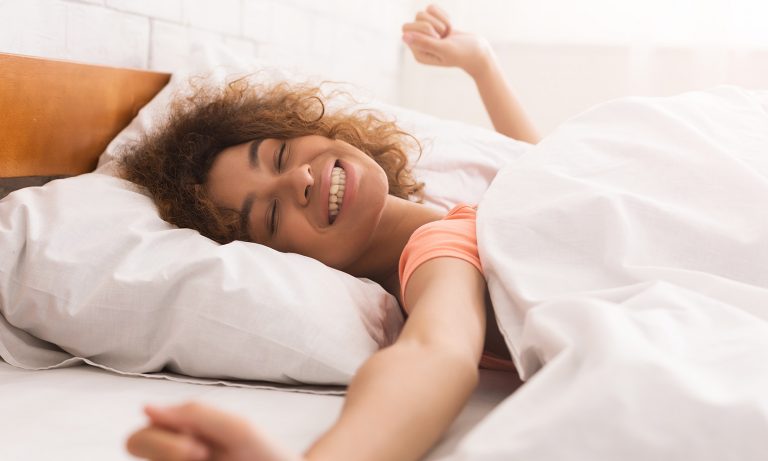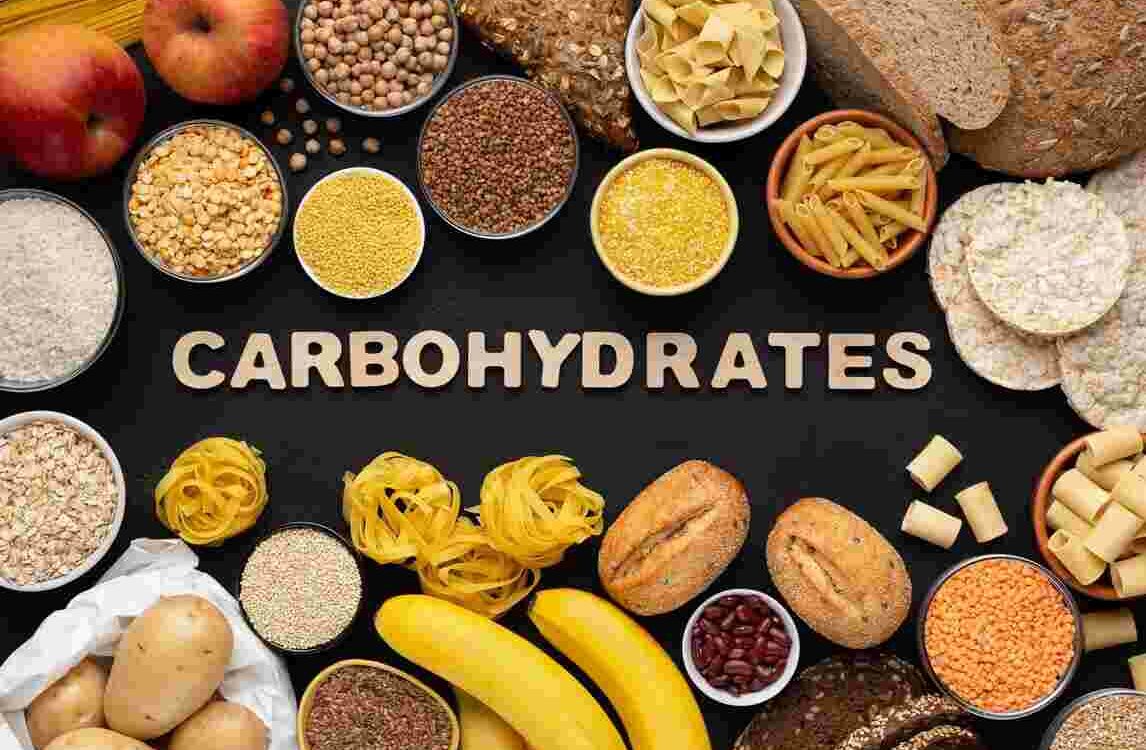Author Archives: Dr. Vaidya Karanvir Singh
URINARY TRACT INFECTION – YOGA ASANAS
- January 27, 2023
- Posted by Dr. Vaidya Karanvir Singh
- 0 Comment(s)
Urinary tract infection is the infection of any part of the urinary system. The urinary system of body consists of kidneys, urinary bladder and urethra. In most of the cases, lower urinary tract is infected. Women are more prone to urinary tract infection as compared to men because the urethra of females is smaller. Urinary system helps in excretion of waste substances from the body. Kidneys remove excess water and waste products from the blood and urine is formed. Urine does not contain any bacteria and moves through the urinary system without contamination. Bacteria enter the urinary system from outside the body thereby causing infection of the urinary tract. When urethra is infected, it is called urethritis, infection of kidneys is called pyelonephritis and infection of urinary bladder is known as cystitis.
There are several types of treatments available for urinary tract infection. However, when infection spreads from urethra to kidneys, it can lead to serious health repercussions.
WHAT ARE THE CAUSES OF URINARY TRACT INFECTION?
Urinary tract infections occur when the bacteria enter the urethra and spread upwards in the kidneys. The urinary system provides defense mechanism which helps in keeping out bacteria. But when the defense mechanism fails, bacterial growth takes place and urinary tract infection occurs. E.coli is the most common type of bacteria involved in urinary tract infection.
Following are the reasons for the occurrence of urinary tract infection:
- Females are more prone as there is shorter than males
- Sexual active persons
- Using birth control measures like diaphragms, using spermicidal creams, etc
- Had a previous urinary tract infection
- Menopause
- Use of catheter
- Kidney stones
- Enlargement of prostate gland
- Weakened immune system
- Recent urinary surgery
WHAT ARE THE SYMPTOMS OF URINARY TRACT INFECTION?
The common signs and symptoms of urinary tract infections:
- Burning sensation during urination
- Increased urination but small amounts of urine pass
- Strong urge to urinate
- Cloudy urine
- Strong odor in urine
- Pain in abdomen or pelvis
- Heaviness in pelvis
- Presence of blood in urine
- Urinary incontinence
- Pain during sexual intercourse
- Fever
- Feeling tired
- Nausea or vomiting
- Pain in back
COMPLICATIONS ASSOCIATED WITH URINARY TRACT INFECTIONS
Urinary tract infections are associated with the following complications:
- Recurrent urinary tract infections
- Infection of kidneys
- Delivering a low-weight baby
- Narrowing of urethra
- Sepsis
- Kidney damage
- Thickening of walls of urinary bladder
YOGA FOR URINARY TRACT INFECTION
Yoga is very beneficial for body and mind relaxation. It helps in managing water content in body. Yoga keeps the internal organs healthy and balances different organ systems. It flushes out various toxins from the body and increases blood circulation to various body parts.
Following are the yoga asanas which are very helpful in management of urinary tract infections:
1. NAUKASANA
Nauka means boat and asana means posture. This yoga asana is similar to the shape of a boat, hence called naukasana.
How to do it:
- Lie on the back with arms beside the body and feet together.
- While taking deep breathe, lift the chest up and feet off the ground and stretch the arms towards the feet.
- Keep the fingers and toes in line with each other.
- Maintain the pose and breathe deeply.
- While exhaling, bring back the arms and legs to the ground and relax.
Contraindications:
- Headache
- Migraine
- Low blood pressure
- Pregnancy
- Menstruation
- Asthma
- Heart patients
2. BHUJANGASANA
Bhujanga means cobra and asana means body posture. Bhujangasana is the cobra or snake pose. It can be done easily at home while lying down on the stomach and then stretching. It gives a good stretch to the body and instantly relieves stress.
How to do it:
- Lie down in stomach with the toes flat and soles facing upwards.
- Rest the forehead on the ground, keep the legs closer with feet and heels touching each other.
- Now slowly lift the body while taking a deep breath in. The navel should be kept in ground level.
- Both the hands should have equal pressure while pulling on and off of the torso from the ground.
- Hold the pose for 4-5 breaths. Then, breathe out and bring the abdomen, chest and head gently on floor.
- Repeat it for 4-5 times.
Contraindications:
- Pregnancy
- Carpal tunnel syndrome
- Hernia
- Recent abdominal surgery
- Fracture of ribs or wrist joints
3. SETU BANDHASANA
It is also known as bridge pose. In this asana, there occurs stretching of chest, neck, back muscles and spine. It is very helpful in relieving back pain and helps in strengthening of bones.
How to do it:
- Lie on the back on the floor
- Press onto the feet and slightly lift the hips upwards. You can slide a yoga block under them for giving support.
- During relaxing, remove the yoga block and bring the legs and hips down on the floor.
Contraindications:
- Pregnancy
- Neck injury
- Stomach ulcers
- Hernia
4. MALASANA
It is the squat pose. It is very beneficial for treating irregular periods.
How to do it:
- Squat with keeping the feet as close together as possible.
- Separate the thighs slightly wider than torso and lean the torso forward.
- Press the elbows along the inner side of thighs and join the palms.
- Hold the posture for 20-30 seconds.
Contraindications:
- Low back pain
- Knee injury
CONSTIPATION – YOGA ASANAS
- January 27, 2023
- Posted by Dr. Vaidya Karanvir Singh
- 0 Comment(s)
- Constipation is a commonly occurring condition in today’s world due to our hectic lifestyle and work environment. It is a condition in which individual has difficulty in empting large bowel and bowel movements becomes less frequent.
- Technically individual having fewer than 3 bowel movements in a week is said to be constipated. However frequency of bowel movement varies from person to person. Some individuals have bowel movements many times a day while others have bowel movement 1-2 times a week. Ever individual have unique bowel movement pattern and as long as the pattern do not change its fine.
HOW DOSE CONSTIPATION HAPPEN ?
This condition happens when colon absorbs too much water content from the stool making it hard and difficult to push out of body.
As ingested food normally moves through digestive tract nutrients are absorbed and the partially digested food which remains in tract moves to large intestine from small intestine. Colon absorbs water from the waste that helps to create stool.
In constipated person the movement of waste is very slowly which give more time for absorption of water from waste. The more the time harder will be the stool.
WHAT ARE THE CAUSES OF CONSTIPATION ?
There are many constipation causes like medications, lifestyle choices, medical conditions and pregnancy.
Lifestyle causes of constipation are :
- Dehydration
- Eating low fibrous diet.
- Stress
- Not doing enough exercise.
- Intake of large amount of milk or cheese
- Change in routine like eating or traveling or going to bed at different times.
- Delaying the empting of bowel
Medications that may cause constipation are :
- NSAIDs like ibuprofen , naproxen etc
- Antidepressants like fluoxetine etc
- Antacids with aluminum or calcium content
- Psychiatric drugs like olanzapine or clozapine
- Strong pain medications like narcotics containing codeine, hydromorphone etc
- Allergy medicines like antihistamines
- Iron pills
- Anti-nausea medicines like ondansetron.
Health conditions which may contributes in development of constipation are :
- Irritable bowel syndrome
- Neurological disorders like multiple sclerosis, Parkinson’s disease, spinal cord injury , stroke etc.
- Intestinal obstruction
- Colorectal cancer
- Lazy bowel syndrome
- Endocrine conditions like diabetes, hyper-calcemia, hypothyroidism. and uremia.
- Structural defects in digestive tract like volvulus, imperforate anus , colonic atresia etc
- Pregnancy
WHAT ARE THE SYMPTOMS OF CONSTIPATION ?
Common symptoms of constipation includes :
- Stool is hard, dry and lumpy
- Difficult or painful defecation of stool
- Fewer than 3 bowel movements in a week
- Stomach cramps or ache
- Nausea
- Bloating
- Feeling incomplete emptying of bowel after defecation
- Loss of appetite
WHAT ARE THE COMPLICATION OF CONSTIPATION ?
If not cured on time it can cause damage which give rise to complication :
- Anal fissure
- Symptomatic hemorrhoids
- Rectal bleeding after straining
- Fecal impaction
AYURVEDIC APPROACH :
In Ayurved it can be correlated with Malabaddhata. According to Ayurved apana vata is responsible for free flow of stool but when its functions are hampered it can result in development of malabaddhata or constipation.
Intake of dry, rough, light quality food, Excessive intake of food with astringent, pungent and salty taste, Night awakening, Less water intake etc are the causes that vitiate the Apana vata in the body.
The vitiated apana vata blocks the lower part ofcolon leading to development of constipation.
HERBS :
- Patola
- Hareetaki
- Draksha
- Jayapala
- Danti
- Castor oil
YOGA ASANAS :
HALASANA (PLOUGH POSE) :
This helps to strengthen stomach and back muscles . It helps to stimulate abdominal viscera and organ thus aids in digestion and relieves constipation. This pose also helps to reduce stress
STEPS:
- Lie down on mat on your back and put hands by your side with palms facing downward.
- Slowly lifting your feet off the ground using abdominal muscles raising leg to make 90 degree angle while deeply inhaling .
- Continue to take normal breaths while supporting your hips and back with your hands and lift them off the ground.
- Gently sweep your legs over the head till yours touches the ground behind your head
- Keep your back in perpendicular angle with the ground.
- Hold the pose for a minute and slowly return to initial position .
PRECAUTIONS :
- Neck pain
- High blood pressure
- Pregnancy
- Spondylosis
- Slipped disc
- Headache
PAWANMUKTASANA (WIND RELIEVING POSE ) :
It aids in removing gas and enhance digestive system. It provide quick relief in flatulence by improving bowel movement. This pose is ideal for constipation and indigestion.
STEPS:
- Lie down on mat on your back and legs stretched forward .
- Slowly inhale and fold the knees and bring them towards chest while hugging them
- Lift the head and tuck your chin into chest to deepen the stretch.
- Hold the posture for a minute
- Gradually return to initial position.
PRECAUTIONS:
- Recant abdominal surgery
- Pregnancy
- Hernia
- Cardiac conditions
- Menstruation
DHANURASANA ( BOW POSE):
It helps to strengthen whole abdominal organs thus improving digestion and prevents constipation. It helps in prevention of disease by improving elimination through intra-abdominal pressure.
STEPS:
- Lie down on your stomach while placing feet slightly apart, parallel to hips and arms on the sides of body.
- Slowly fold your knees up and hold ankles with your hands to stabilized the pose.
- Take deep breaths and slowly lift the chest off the floor and pull legs toward your back
- Hold the posture for few seconds
- Slowly exhale and return to initial position
PRECAUTIONS :
- High blood pressure
- Headache
- Migraine
- Insomnia
- Hernia
BALASANA (CHILD’s POSE):
It contracts abdominal organs , improve blood circulation thus aids in bowel movements. With regular practice individual can make his bowel movements healthy.
STEPS :
- Sit on your heels on the ground with big toes touching each other and knees at hip-width apart.
- Taking deep breaths start bending forward slowly stretching chest and arms forward.
- Ret your head on ground with arms stretched over head.
- Hold the posture for few deep breaths and gradually return to sitting position.
PRECAUTIONS :
- Ankle injuries
- Low blood pressure
- Knee injury
- Pregnancy
- Diarrhea
ULCERATIVE COLITIS – YOGA ASANAS
- January 27, 2023
- Posted by Dr. Vaidya Karanvir Singh
- 0 Comment(s)
Yoga is not only treats health conditions but also helps to maintain healthy body by maintaining body-mind balance. Ulcerative colitis is said to have connection with mental stress as it tends to relapse during spell of intense stressful episodes.
Yoga asanas helps to relive the stress from body and mind thus helpful in managing relapse of Ulcerative colitis. Asanas helps to calm down nervous system which keeps the inflammation of mucosa of colon in check. So yoga asanas improves the quality of life of individual suffering from Ulcerative colitis.
WHAT IS ULCERATIVE COLITIS ?
It is thought to be Auto-immune condition. Irritation and Ulcers in large intestine are the main feature of Ulcerative Colitis. This disease comes under a group of conditions called as Inflammatory Bowel disease (IBD) . The inflammation generally starts in rectum close to the anus which gradually spreads and affects a portion of entire colon in individual.
- When the inflammation is in rectum and lower part of colon it is known as Ulcerative Proctitis .
- But when it affects the entire large intestine it is named Pancolitis .
- Only left side is affected with inflammation that it is named Limited or distal Colitis.
The amount of inflammation and location accounts for the severity of Ulcerative colitis. There is a pattern of flare-up when the symptoms are worse. It is a treatable condition which tends to get better with right approach.
WHAT ARE THE CAUSES OF ULCERATIVE COLITIS ?
It is a complex disease which involves many factors. It is mainly said to be a result of an Overactive immune response of body where immune system attacks its own body cells and tissues causing damage and inflammation.
Some of the factors that increase the risk of developing this conditions includes :
- Age : Individual between age group of 15-30 or older than 60 are at higher risk of developing Ulcerative colitis.
- Dietary habits : Intake of High fat diet can put an individual at higher risk.
- History : Individual with family history of Inflammatory bowel disease can increase the risk of developing Ulcerative colitis .
- Certain medication : Use of NSAIDs like ibuprofen etc can weakens immune system leading to increase risk of disease.
WHAT ARE THE SYMPTOMS OF ULCERATIVE COLITIS ?
Some of the common symptoms of ulcerative colitis in beginning includes :
- Abdominal cramps
- Nausea
- Diarrhea
- Tiredness
- Weight loss
- Anemia
Symptoms developed in later stages includes :
- Fever
- Mucus, blood or pus in bowel movements
- Skin rashes
- Severe cramps
- Joint pain
- Liver disease
- Mouth sores
- Red and painful eyes
- Loss of nutrients and fluids
AYURVED APPROACH :
In Ayurved it is correlated with Grahani in which Pitta dosha get vitiated in comparison to other two doshas. Due to Nidan sevan like eating hot and spicy food, unwholesome food , anger etc causes vitiation of Pitta dosha . The vitiated pitta dosha in turn contaminates rakta(blood) and mamas ( muscle) dhaute leading to ama formation. The ama dosha than obstructs annavaha and purishavaha srotas( channels) causing development of the disease in individual.
Herbs :
- Ginger
- Cumin
- Coriander
- Jamun
- Kutaja
- Turmeric
- Bilwa
- Dadim
Panchakarma :
- Vamana
- Pittahara vasti
- Virechana
- Piccha basti
YOGA ASANAS
1. Bhujang Asana (cobra pose) :
This asana affects abdominal muscles and also massages abdominal organs thus helps to relieve flatulence . It also improves gastro-intestinal symptoms like indigestion, low digestive fire, constipation etc. It also tones hip muscles and improves spine’s flexibility.
STEPS :
- Lie down on your stomach on mat putting forehead facing downward.
- Keep legs straight with feet hip-width apart and toes pressing downward.
- Place hands on mat beside ribs and lightly pressing down on ground.
- Slowly lift head ,shoulders and chest off the mat keeping back of neck long.
- Push chest forward while straightening the arms and try to coil thoracic spin keeping lower belly connected to mat.
- Hold the pose for few breaths and then gradually bring the head and chest down to mat while exhaling.
PRECAUTIONS :
- Carpal tunnel syndrome
- Injury to arms, back or shoulder
- Recent abdominal surgery
- Pregnancy
- Hernia
2. PASCHIMOTTAN ASANA (SEATED FORWARD BEND) :
It helps to improve efficacy of spinal nerves. It also helps to remove abdominal fat and improve digestion. It is affective in constipation, flatulence, anorexia etc thus beneficial in ulcerative colitis.
STEPS:
- Sit down on mat with legs stretched forward with toes flexed towards torso and spine erect .
- While breathing ,slowly move both arms up over the head so they are stretched upwards.
- Start to exhale while moving body forward from hip joint such that chin moves towards toes.
- Hold big toes with both hands and touch forehead with the knees.
- Make sure the elbows are touching the ground.
- Hold the posture for some time and then slowly return to the sitting position .
PRECAUTIONS :
- Herniated disc
- Pregnancy
- Sciatica
- Hypertension
- Injury to knees, hip , rib etc.
- Ligament tear in calves, hamstring etc.
3. VAJRASANA (THUNDERBOLT POSE):
This asana improves the circulation of blood in lower abdomen thus helps to improve digestion, Relieves gas and pain in stomach. It also relaxes waist and hip region providing relief from menstrual cramps.
STEPS :
- Sit down on mat with legs stretched outwards.
- Slowly fold both legs and sit in kneeling pose keeping hips on heels with toes pointed behind touching each other.
- Sit on pit formed by parted heels comfortably
- Keep head, neck and spine straight and place both palms on thighs facing upwards.
- Hold the pose for 30 seconds to 1 minutes while taking deep breaths.
- Slowly start to return in sitting position while exhaling.
PRECAUSTIONS :
- Slip disc
- Injury to knee ort foot
- Ankle stiffness
- Intestinal ulcers
- Hernia
4. SETU BANDH ASANA (BRIDGE POSE):
It helps to calm the mind thus reduces stress and anxiety. It also helps to improve digestion and relieves symptoms of menstrual cramps and menopause.
STEPS:
- lie down on your back on the mat keeping knees bent at hip width apart and heels of both feet facing towards hips.
- Keep arms on side of body and palms facing downwards
- Slowly start to lift spine from the mat while raising hips as high as comfortable.
- Roll both shoulder during raising chest so that the chin touches the chest
- Support weight of whole body on shoulders, arms and feet and support back with the palms
- Take deep breaths and hold the pose for few seconds
- Gradually return to the initial position and relax.
PRECAUSTIONS :
- Hernia
- Intestinal ulcers
- Neck injury
- Pregnancy
- Migraine
PREMENSTRUAL SYNDROME – YOGA ASANAS
- January 27, 2023
- Posted by Dr. Vaidya Karanvir Singh
- 0 Comment(s)
INTRODUCTION
Premenstrual syndrome is a group of physical, emotional and behavioral changes which occur in females before menstruation. It usually starts between ovulation and the onset of next periods. It lasts for a few days and lasts till the beginning of the upcoming period. The common signs and symptoms include tenderness in breasts, food cravings, mood swings, irritability and depression. Nearly every 3 out of 4 women experience premenstrual syndrome. The symptoms vary from person to person and their intensity ranges from mild to severe.
Premenstrual syndrome can have an impact on the daily life of an individual. But with the dietary and lifestyle modifications, the symptoms of premenstrual syndrome can be managed. There are various medicines also which are beneficial in it.
WHAT ARE THE CAUSES OF PREMENSTRUAL SYNDROME?
The exact cause of premenstrual syndrome is not known but is believed to be due to several factors. Following are the reasons which can be responsible for premenstrual syndrome:
- Hormonal fluctuations
- Fluctuation in serotonin – a neurotransmitter that plays a role in mood states
- Depression
- Cigarette smoking
- Lack of physical exercise
- Sedentary lifestyle
- Lack of sleep
- Eating foods rich in sugar, fat and salt
WHAT ARE THE SIGNS AND SYMPTOMS OF PREMENSTRUAL SYNDROME?
The common signs and symptoms of premenstrual syndrome are:
- Abdominal cramps
- Bloating
- Tenderness in breasts
- Body pains
- Swelling in hands and feet
- Acne
- Headache
- Diarrhea or constipation
- Increased appetite
- Increase in body weight
- Stress
- Anxiety
- Difficulty in sleeping
- Forgetting things
- Mood swings
- Crying
- Angry outbursts
- Lack of concentration
- Social withdrawal
- Lack of interest in daily activities
- Back pain
- Clumsiness
- Decreased sexual drive
HOW PREMENSTRUAL SYNDROME CAN BE PREVENTED?
Premenstrual syndrome can be managed by a lot of ways. The symptoms will not be totally vanished but they can be lessened to such an extent that it does not interfere in the life of an individual. Following are the steps which are good for prevention of PMS:
- Do regular exercise for 20-30 minutes a day
- Eat healthy diet which includes fruits, vegetables, whole grains, etc
- Take proper sleep of 7-8 hours
- Avoid excess intake of salt and caffeine
- Say no to alcohol
- Quit smoking
YOGA FOR PREMENSTRUAL SYNDROME
Yoga is an ancient science which involves various types of asanas for body and mind relaxation. It helps in stretching of body and releasing pressure from the body. Different types of yoga asanas are very helpful in managing symptoms of premenstrual syndrome. Following are the yoga asanas beneficial in PMS:
1. MARJARIASANA
Marjari means cat and asana means body posture. Marjariasana is called cat stretch. It is an excellent stretching posture.
How to do it:
- Come onto the fours- arms and legs, with back forming the top of the table.
- Arms should be perpendicular to the floor and knees are hip-width apart from each other.
- While inhaling, raise the chin and bend the head backwards. Push the navel downwards and raise tailbone.
- This is the cat pose. Hold it for 1-2 minutes and take deep breathes.
- Then exhale and release the pose gradually.
- Do the pose for 4-5 times.
Contraindications:
- Neck injury
- Back injury
2. BHUJANGASANA
Bhujanga means cobra and asana means body posture. Bhujangasana is the cobra or snake pose. It can be done easily at home while lying down on the stomach and then stretching. It gives a good stretch to the body and instantly relieves stress.
How to do it:
- Lie down in stomach with the toes flat and soles facing upwards.
- Rest the forehead on the ground, keep the legs closer with feet and heels touching each other.
- Now slowly lift the body while taking a deep breath in. The navel should be kept in ground level.
- Both the hands should have equal pressure while pulling on and off of the torso from the ground.
- Hold the pose for 4-5 breaths. Then, breathe out and bring the abdomen, chest and head gently on floor.
- Repeat it for 4-5 times.
Contraindications:
- Pregnancy
- Carpal tunnel syndrome
- Hernia
- Recent abdominal surgery
- Fracture of ribs or wrist joints
3. DHANURASANA
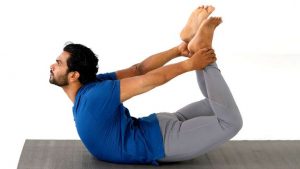
Dhanu means bow and asana means body posture. In dhanurasana, the shape of the body is made like that of a bow. The pose should be performed 4-5 hour after meals. The best time is of early morning.
How to do it:
- Lie in the stomach with the feet apart.
- Then fold the knees and take your hands backwards and hold the ankles.
- Breathe in and lift the chest up from the ground. Pull the legs upwards and more towards the back.
- Keep the body posture stable and see forward. Pay attention to the breath.
- Maintain posture for 15-20 seconds and bring the legs and chest gently to the ground.
Contraindications:
- Neck injury
- Hernia
- Hypertension or hypotension
- Lower back pain
- Migraine
- Recent abdominal surgery
4. MATSYASANA
Matsyasana is the fish pose asana. If this asana is carried out in water, the body will float easily like a fish.
How to do it:
- Lie on back with feet together and hands relaxed.
- Place the hands under the hips and bring the elbows close to each other.
- Lift the head and chest up while breathing in.
- When the chest is elevated, lower the head backwards and touch floor with the top of the head.
- Hold the pose as long as a person feels comfortable.
Contraindications:
- High or low blood pressure
- Migraine
- Insomnia
5. SHAVASANA
Shava means corpse and asana means body posture. Shavasana is also known as corpse pose. This asana is a rest and relaxation posture. It is usually performed at the end of a yoga session. It helps in deep healing of the body.
How to do it:
- Lie flat on the back without any cushions or props. Close your eyes.
- Keep the legs apart comfortably and let the feet and knees relax.
- The arms should be kept aside with a little distance from the body. Keep the palms open and facing upwards.
- Breathe slowly and gently and slowly relax your entire body. Surrender the whole body and let go everything. But do not fall asleep.
ALZHEIMER’S DISEASE – YOGA ASANAS
- January 27, 2023
- Posted by Dr. Vaidya Karanvir Singh
- 0 Comment(s)
Alzheimer’s disease is a progressive neurologic disorder that causes brain to shrink (atrophy)and brain cells to die . It is the most common cause of dementia and usually affects people over the age of 65 years.
SYMPTOMS:
- MEMORY LOSS : Memory loss is the symptom of alzheimer’s disease . everyone has occasional memory loss but the memory loss associated with Alzheimer’s disease persist and worsen ., affecting the ability to function at work or at home. People with this disease :
- Repeat statements again and again .
- Getting loss in familiar places .
- Having a trouble to find the right words , to identify objects ,express thoughts or take part in conversation.
- THINKING : This disease cause difficulity in concentration and thinking
- CONFUSION WITH TIME AND LOCATION : It cause a decline in the ability to make reasonable decision and judgements in everyday situations.
- DIFFICULITY IN COMPLETING FAMILIAR TASKS: People with this disease forget how to perform basic tasks such as dressing and bathing .
- CHANGES IN PERSONALITY AND HABITS : It can affect mood and behaviours . Problem may include :
- Depression
- Apathy
- Mood swings
- Loss of inhibitions
- Changes in sleeping habits .
- Delusion
STAGES OF ALZHEIMER’S DISEASE ARE:
- Preclinical alzheimer’s disease .
- Mild cognitive impairement .
- Mild dementia due to alzheimer’s disease .
- Moderate dementia due to alzheimer’s disease .
- Severe dementia due to Alzheimer’s disease .
OTHER STAGES ARE:
- Mild (early)
- Moderate (middle)
- Severe ( late)
RISK FACTORS:
- AGE: Increasing age is the greatest known risk for alzheimer’s disease. It is not a part of normal aging but as you grow older the likelihood of developing alzheimer’s disease .
- FAMILY HISTORY :If someone in your family(sibling, parent) , relative , suffering from this disease in which person there is a developing risk of alzheimer’s disease .
- HEAD INJURIES.
- AIR POLLUTION .
- MORE INTAKE OF ALCOHOL.
- DISTURBED SLEEP PATTERNS
- LACK OF EXERCISE
PREVENTION OF ALZHEIMER’S DISEASE :
- Exercise regularly
- Eating a low saturated diet such as meditarranean diet .
- Quit smoking .
- Logic game
- No alcohol.
Ayurvedic approach of alzheimer’s disease
Among the three dosha vata is the motivating force behind the other doshas (pitta and kapha) and all the dhatus, mala. Increase in the vata dosha leads to dhatukshya and it creates a pathological condition similar to that of Alzheimer,s disease .When vata increases in the Manovaha Srotas malfunction of the mental activities. Imbalance in vata dosha also leads to imbalance in the Trigunas (Satva, Raja and Tama) and as a result, there is Smriti Nasha (loss of memory). Increase in the vata dosha may also lead to generalized weakness of the nervous system, body gets depleted and stops functioning.
YOGA ASANA FOR ALZHEIMER’S DISEASE :
1. VRIKSHASANA :
Method
- Firstly Stand straight.
- Balance firmly left leg and lift your right leg. Bend your knee of the right leg.
- place your right foot inside of your left thigh with toes of right foot keeping downward.
- Join your palms at chest level. Slowly lift both arms over the head and keep hands stretched upward.
- Hold the position while breathing deep.
- Lower your arms to chest level and then separate your palms.
- Straighten right leg and stand erect again.
- Repeat the posture with your right leg.
Benefits:
- Improve balance and stability in
- Strengthens the ligaments and tendon of the feet.
- Strengthens and tones the entire standing leg, up to the buttocks.
2. Ustrasana or camel pose
Method
- Sit on the floor stretching your leg and keep spine erect and palms on the ground side by the buttocks.
- Bend your leg by the keens and sit on your heels placing the buttocks in between the heels, the right big toe overlapping the left toe .
- keeping your knees in line with the shoulders and sole of the feet facing downward
- Put hand on thighs.
- Inhale and arch your back and put your palms on the heels of the feet.
- Keep your arms straight.
- Do not strain your neck keep it neutral. Neck will be free.
- Stay in this final position for couple of breaths or as much you can do it with easy way .
- Breathe out and slowly come to normal position withdrawing your hands from the feet.
Benefits:
- Imroves flexibility of spine and strengthens it.
- Improves digestion
- Gives relaxation to the lower back.
- Indigestion
- Reduces abdomen fat.
- Thyroid and parathyroid.
- Menstrual problems.
3. Bhujangasana or Cobra pose of Yoga
Method:
- Lie in prone position
- Palms by the side of your chest, arms close to the body, elbows pointing outward. Inhale and raise your forehead, neck and shoulders.
- Raise your trunk with the help of your arms.
- Look upward while breathing normally.
- Make sure stomach touches on the floor.
- Hold the pose for 5 seconds.
- Slowly comes into prone position
- Turn your head to one side and arms by the side of body.
Benefits:
- It may help to stretch muscles of the chest, shoulders, and abdominal area.
- It help to enhance anxiety.
- It may rejuvenate the heat and elevate the mood.
- It may decrease the stiffness of lower back .
4. Balasana or Child’s Pose
Method:
- Spread a mat and kneel on it
- Sit on your kneel ,touch big toes to each other and separate knees to a hips –wide width
- Take a deep breathe , exhale, and place down torso in between the thighs.
- Sacrum spread across your pelvic back.
- While lifting the base of skull apart from the back to neck and stretch the tailbone away from the back of pelvis
- Place down your torso on the mat and put your hands down and palm up
- Push the shoulder towards mat . you feel like pull of your shoulder blade
Benefits:
- It helps to reduce stress and anxiet .
- It relaxes the back and spine.
- It is highly recommended to people who feeling dizzy.
- It gives good stretch to the legs , ankles, thighs, and hips.
4. Parivrtta Parsvakonasana or revolved side angle pose
Method:
- Start with downward facing dog pose of Yoga with feet grounded and palms placed firmly on the floor.
- Inhale and bring your right foot forward between both your palms.
- Keep the back of your left leg straight and tuck in your toe in while lifting up the heel.
- Exhale, push your pelvic down and take your right thigh parallel to the ground.
- Inhale, lift up your right hand with fingers pointing towards the ceiling.
- Make sure that both your shoulders are aligned.
- Gaze up towards your outstretched fingers and hold onto the pose for 10 to 15 seconds before releasing the posture.
Benefits:
- It makes muscle stronger and decrease the stiffness of lower back.
- It also improves digestion and relieve constipation .
- Increases lung capacity.
- Reduce body fat .
Precautions:
Those suffering from asthma, diarrhea, vertigo, migraine, insomnia issues, neck or back injuries or low/high blood pressure should consult their doctor before performing this pose .
BODY TOXINS AND ITS AYURVED CONCEPT
- January 25, 2023
- Posted by Dr. Vaidya Karanvir Singh
- 0 Comment(s)
Body toxins or metabolic toxins are natural by-products of metabolism that occurs throughout the body systems that must be eliminated from the body. There is long list of metabolic pathway that creates variety of metabolic toxins in body like :
- Amino acid metabolism
- Intestinal dysfunctions
- Neurotransmitter metabolism
- Toxin metabolism
- Vitamin metabolism
- Detox dysfunctions and impairments
- Carbohydrate metabolism
If there is hindrance in elimination of toxins from the body it can lead to damage to organs and development of various health conditions . Like excessive production of ammonia in urea cycle leads to serious health problems .
ACCUMULATION OF VARIOUS BODY TOXINS
Certain body toxin which are not flushed out from body due to any cause accumulates in body. Some of the body toxins are :
Hyperammonemia :
Ammonia is a waste product which is normally processed in liver and excreted through urine. High level of ammonia in blood is called as Hyperammonemia and can be toxin to CNS .
What are the causes of Hyperammonemia ?
Common causes are :
- Decreased blood flow to liver
- Liver diseases
- Renal failure
- Hepatic encephalopathy
- Reye’s syndrome
What are the symptoms of Hyperammonemia ?
Common symptoms of hyperammonemia includes :
- Abdominal pain
- Irritability
- Headaches
- Nausea and vomiting
- Behavioral changes
- Ataxia
- Seizures
- Coma
- Hyperventilation
Symptoms of mild hyperammonemia in children are :
- Hypotonia
- Failure to thrive
- Neurodevlopment delays
Uremia :
Build up of toxins like urea and creatinine in blood because kidneys stop filtering toxins out through urine. Untreated uremia can lead to serious health conditions or even death.
What are the causes of Uremia ?
Uremia is caused due to extreme and irreversible damage to kidneys .This is mainly from chronic kidney disease where kidneys are no longer able to filter waste of body and flush it out through urine. Common cause of Chronic kidney disease includes :
- Polycystic kidney disease
- Inflammation of glomeruli
- High bload pressure
- Diabetes
- Inflammation of kidney ‘s tubules and structure around them.
- Enlarged prostate.
- Recurring kidney infections
What are the symptoms of Uremia ?
Common symptoms of uremia includes :
- Muscle cramps
- Fatigue
- Shortness of breath from accumulation of fluid
- Cognitive dysfunction
- Nausea
- Itching
- Unexplained weight loss
Hyperuricemia :
Accumulation of too much uric acid in body leads to condition called Hyperuricemia . If left untreat can lead to permanent damage to bones, tissues and joints etc.
What are the causes of Hyperuricemia ?
Individual is producing to much uric acid due to :
- Excessive intake of purine rich diet like meat, sea-food , beer etc.
- Break down of body cells due to certain conditions and exercise.
Not able to excrete uric acid from body due to :
- Acid and base imbalance
- Improper kidney functions
- Down syndrome
- Certain medications like cyclosporin, ethambutol, niacin etc
- Hypothyroidism
What are the symptoms of Hyperuricemia ?
Common symptoms of Hypreuricemia are :
- Joint pain mainly in big toe
- Nausea
- Vomiting
- Kidney stones
AYURVEDIC APPROACH :
In ayurveda accumulation of body toxins is correlated to Formation and accumulation of Ama in the body.
Ama is a product of indigestion in stomach which causes many systemic diseases. The immature digestive juices stagnated for longer duration sourness due to fermentation and decay is called ama which gets absorbed in system and put in circulation . When put in circulation it reaches various channels and tissues in body leading to their blockage giving rise to various health conditions.
What are the properties of ama ?
- Asamyuktam : It is non-homogenous compound of food which is not accepted by body cells. So it is nor absorbed neither processed thus becomes toxic and dangerous to body .
- Avipakum : Improper digested food forms ama so it is also in improperly digested form.
- Durgandham : It has natural foul smell due to unprocessed form of digestive juices.
- Pichchila : It is sticky in nature thus adheres to wall of cells and channels of body causing their blockage.
- Dravam : It is in liquid state.
- Guru : It is heavy in nature
- Tantumat : Has thready like appearance
- Nana varna : It has various colors
- Snigdha : It is very similar to fat and kapha in appearance and unctuous in nature.
- Sadanam sarva gatrani : It causes severe debility and heaviness in body.
- Srotamsi abhishyandayati : It cause oozing and blockage in body channels
- Ashukari : It is quick to spread in whole body
What are the causes of Ama formation in body ?
Some common causes of formation of ama in body are :
- Improper food combinations
- Fried food intake
- Overeating or emoitional eating habits
- Intake of highly processed food
- Excessive intake of sour, sweet or salty food.
- Lack of exercise
- Eating or sleeping before proper digestion of food
- Detrimental life style
- Sleeping in day time
- Irregular eating habits
What are the symptoms produce by ama in body ?
Ama causes various digestive symptoms like :
- Diarrhea
- Constipation
- Bloating
- Indigestion
- Fatigue after eating
- Gas
- Sinking stool and mucus in stool
Other symptoms produced in body by Ama are :
- Poor circulation
- Joint inflammation and pain
- Depression and other disorders related to mood
- Deficiencies of vitamins and minerals
- Skin dryness and blemishes
- Fever
- Fatigue in body
Healthy conditions may caused due to Ama accumulation in body
- Gout
- Gallstones
- Rheumatoid arthritis
- Late-onset Diabetes
- Leukocytosis
- Glaucoma ( increased intraocular pressure )
- Kidney stones
- Tumors
Treatment Principles of Ama :
Apatarpana (Depletion )treatment is used for treatment of ama and diseases caused by ama in body. it includes :
- Langhan
- Pachana
- Dosha avasechana
PANCHAKARMA THERAPIES FOR AMA :
Panchakarma treatments are cleansing and detoxification treatments which not only treats ama and conditions associated with ama dosha but also rejuveniates and revitalize whole body . Some of the panchakarma procedures helpful in ama dosha are :
- Swedan
- Vaman
- Virechan
- Vasti
- Leech therapy
HERBS
- Cinnamo
- Kutaja
- Neem
- Turmeric
- Ginger
CHANDIGARH AYURVED CENTRE MEDICATION FOR body detox
1. Detox Premium Powder:
The powder contains all the Ayurvedic herbs which strengthen the immune system of the body and prevents the complication of dengue by potentiating immune system. It helps in controlling the disease within a period of 4 to 8 days. The powder includes.
Parwal Pishti – Parwal pishti is prepared from Coral calcium. It is mainly used in Pitta related disorders and helpful in bleeding disorders. This pishti relieves Ama dosha and improves the digestion power. It also improves the strength and immunity.
Shukta Pishti – It is prepared from Pearl oyster shell. Shukta pishti pacifies Pitta and Kapha dosha. It is the best ant-acid and relieves the abdominal distention. Shukta pishti reduces the rashes on the arms and legs.
Giloy Satva–Giloy satva includes water-soluble extract of Giloy/Guduchi (Tinospora Cordifolia). It balances the aggravated pitta and acts as a mild-antipyretic, antacid, and immuno-modulator. It also reduces burning sensation in the hands, feet, and body.
Kamdudha Ras–According to Ayurveda principles, Kamdudha Ras has Sheeta Virya thus it is beneficial in every Pitta Roga classified in Ayurveda. It is beneficial in the symptoms like burning sensation, restlessness, bleeding tendencies, excessive thirst, and hot flashes, vomiting with yellowish or sour water.
Akik Pishti – Akik bhasma contains Silicon Dioxide and some herbal extracts derived into in during processing with Aloe vera and Rose water. It is used in General debility, Restlessness. It works well in loss of appetite, weight loss, and feeling of excessive heat in the body.
Ghandak Rasayan – Ghandak Rasayan is a great antibacterial, antiviral ayurvedic medicine. It acts as an anti-pyretic, analgesic, & blood purifier.
Sutshekhar Ras–It is an important medicine used in Ayurveda, which acts on Pitta dosha and reduces the symptoms like nausea, vomiting, fever, headache, sour taste of mouth, restlessness, etc.
Recommended Dosage – Take 1 sachet twice a day with normal water.
2. Rasayan Vati:
Rasayan vati is herbo-mineral ayurvedic formulation, which is 100% natural. Rasayan vati contains various herbs such as Aswagandha, Shilajeet, Amla, Kesar, Musali, Shatavar, Brahmi Abhrak Bhasam, Swarn Makshik Bhasam, Yashad Bhasam, Mukta pisti, Praval pisti, Jaiphal, Vang Bhasam, Dalchini, Javitri, Gokhru, Kaunch Beej, Saunth, Mirch, Pipli, Amla, Kesar, Manjith, Anant Mool, Brahmi, Musali, Swarn Vang, etc. These ingredients show antioxidant, aphrodisiac, anti-inflammatory, antipyretic, analgesic, immuno-modulator properties.
Recommended Dosage: Take 2 tablet twice daily.
3. Detox tablets:
This Tablet is herbo-mineral pure Ayurvedic preparation. It contains ingredients like Parwal Pishti, Shukta Pishti, Giloy Satav, Kamdudha Ras, Jahar Mohra, Akik Pishti, Gandhak Rasayan, Shankh Bhasma, Sutshekhar Ras, Sudhyog Tab, Shwet Parpati, Yavakshaar, etc. This tablet increases overall immunity, improves digestion, relieves acidity, helps in fever, nausea, vomiting, high blood pressure, mental diseases and eye diseases. It also helps in removing impurities and detoxifies the body.
Recommended Dosage: Take 1 tablet twice daily.
4. Herbal Tea:
HERBAL TEA is a herbo-mineral preparation and is purely Ayurvedic formulation. CAC Herbal Tea helps in detoxification of the body, helps in Weight loss, Improves brain functions, fights cold, reduces heavy cough, and lowers cholesterol. Herbal Tea shows Anti-hypertensive, Anti-inflammatory, Antioxidant, Anti-ageing, Anti-depressant, and Immune-modulator properties.
Recommended Dosage: For 1 cup of herbal tea- boil 1 teaspoon of Herbal Tea in about 2 glasses of water and boil it until remaining half glass. For slimming purpose prefer this herbal tea with lemon on an empty stomach.
REASONS OF UNSTABLE BODY MOVEMENTS IN AYURVEDA
- January 25, 2023
- Posted by Dr. Vaidya Karanvir Singh
- 0 Comment(s)
OVERVIEW :
According to ayurveda doshas are of three types vata, pitta and kapha . out of three Vata dosha is responsible for the movements in body . vata dosha is the most important . without vata, pitta and kapha cannot move. Every movement of the body eyes blinking , heart beating, talking ,jumping, circulation and elimination because of vata .vata is the air principle . it consist of the space and air elements .vata dosha is said to be powerful because
- It is quick acting
- It is very strong
- It has capacity to vitiate other dosha , tissue , excreta of body create a base for many diseases .
- It is one of the independent body element that controls everything .
DEFINITION OF VATA :
That which cause gati (movement ) is called as vata .
TYPES OF VATA :
PRANA VAYU :Located IN HEAD
UDANA VAYU : Located IN CHEST
SAMANA VAYU : Located IN STOMACH AND INTESTINE
VYANA VAYU: Located IN HEART
APANA VAYU : Below NAVEL
VATA DOSHA CHARACTERSTICS :-
- Vata is dry , mobile , cold, rough,sharp, subtle,light .The individual having vata dominance reflect these qualities in body and mind such as:
- Sleepless
- Slim and flexible .
- Kind by nature
- Constipation
- Love sour ,salty foods
- Physical active but low stamina and getting overtired easily
- Dreams full of movements.
- Quick and creative minds and found of dancing or travelling.
SYMPTOMS OF VATA IMBALANCE BODY :-
- Susceptible to anger
- Sensitive to cold weather
- Poor blood circulation.
- Appetite can vary .
CAUSES OF IMBALANCING VATA :
- Excessive exercise and sexual intercourse .
- Fall, injury ,fractures
- Excessive awakening at night
- Suppression of all natural urges .
- Excessive consumption of cold foods and activities.
- Fear and irritation.
- Excessive consumption of dry foods , astringent, bitter, and pungent .
- At evening during cloudy and rainy season
VATA DOSHA V/S AIR OUTSIDE THE BODY:
Vata is the representative of air element present outside the body. air outside body distributes heat and coldness and maintains their balance through vikshepa (distributing) function . Similarly vata dosha in our body will maintain balance of heat caused by pitta and coldness caused by kapha .
VARIATIONS OF VAYU:-
- STHANA :state of balance
- VRIDDHI: pathological increase
- KSHAYA :-pathological decrease
VATA DOMINANCE DURING A DAY :-
- AM,PM vata is dominant .
VATA BALANCING DIET:
- All sweet food pacify Vata and may be taken in moderation.
- Fats and oils are beneficial in the digestive system and help reduce Vata. Use up to 2 teaspoons daily of ghee (homemade ghee is best) or olive oil.
- Milk is easier to digest when warm or heated.
- Rice and wheat are the best grains for balancing Vata. Reduce the amount of barley, corn.
- Heavy fruits such as: bananas, avocados, mangoes, apricots, plums, coconut, figs, orange, lemon, papaya, peaches, pineapples, kiwi, dates and dried fruits.
- Eat fewer dry or light fruits such as apples, cranberries, pears, and pomegranates. Fruits should not be eaten after meal.
- Cooked vegetables are best. Raw vegetables should be minimized.
- Beans, Sprouts and cabbage tend to produce gas and should be minimized.
- Spices that pacify Vata include cardamom, cumin, ginger, cinnamon, salt, cloves, mustard seed, cilantro, fennel, oregano, sage , thyme, and black pepper.
- All varieties of nuts are recommended.
- Always eat cooked and warm food.
PANCHKARMA PROCEDURES FOR PACIFYING VATA :-
- Snehan
- Swedana
- Basti
COMMON TYPE OF MOVEMENT DISORDER ARE :
Ataxia. Impaired balance or coordination can be due to damage to brain , nerves or muscles.
Cervical dystonia. It is a painful condition in which neck muscles contract involuntarily into abnormal position. It can cause repetitive twisting movements of your head and neck. It is also called spasmodic torticollis.
Chorea. It is a movement disorder that causes sudden and uncontrolled jerky movements of the legs, arms, and facial muscles.
Dystonia. It is a condition in which sustained involuntary muscle contractions with twisting and repetitive movements.
Multiple system atrophy. It is a rare condition in which nervous system causes damage to nerve cells in the brain It can also cause low blood pressure, impaired bladder function and acting out dreams.
Parkinson’s disease. It is a brain disorder that causes uncontrolled movements such as shaking , stiffness, and difficulity with balance and coordination.
Parkinsonism. it is a general term for slowness of movement along with stiffness, tremor or loss of balance. Parkinson’s disease and certain dopamine blocking medications are the most common causes.. Stroke or repeated head trauma also can cause parkinsonism.
Progressive supranuclear palsy. It is a neurological disorder that causes problems with walking, balance and eye movements. It sometimes may resemble Parkinson’s disease but is a distinct condition.
Restless legs syndrome. This movement disorder causes unpleasant feelings in the legs while relaxing or lying down, often relieved by movement.
Tourette syndrome. It is a neurological condition that starts between childhood and teen age and is associated with repetitive movements and vocal sounds.
Tremor. This movement disorder causes rhythmic shaking of parts of the body, such as the hands, head or other body parts.
Wilson’s disease. It is a rare, inherited disorder that causes excessive amounts of copper to build up in the body and cause a neurological problems, tremor,dystonia
PHOBIA
- January 25, 2023
- Posted by Dr. Vaidya Karanvir Singh
- 0 Comment(s)
The word phobia is derived from the greek word which means extreme fear and flight .It is a type of anxiety disorder that causes an uncontrolled ,irrational fear of certain ,object , or activity.it is a rapid onset of fear. If the object or situation cannot be avoided they experience significant distress.people of all ages and from all walks of life across the world develop phobic reaction .phobia are very common in women.
TYPES OF PHOBIA :-
Three main types of phobia are:-
1.SOCIAL PHOBIA
2. AGORAPHOBIA
3. SPECIFIC PHOBIA
1. SOCIAL PHOBIA :-
It is defined as to feel nervous in some social situation.Fear of situation in which you may be judged negatively ,worry about embarrassing or impaired ability to function in atleast some aspect of daily life .
2. AGORAPHOBIA :-
It is a type of anxiety disorder which involves fearing of open spaces , crowds or in situation that the person cannot leave easily .
3. SPECIFIC PHOBIA :-
- Acrophobia :-fear of heights.
- Angrophobia:-fear of anger.
- Autophobia :-fear of being alone .
- Anthrophobia:-fear of people
- Arachnophobia:-fear of spiders.
- Bacteriophobia :-fear of bacteria .
- Belonephobia:-fear of pins and needles .
- Bibliophobia :-fear of books .
- Cynophobia :-fearof dogs .
- Equinophobia:-fear of horses.
- Emetophobia:-fear of vomiting .
- Erotophobia:-fear of sex .
- Hydrophobia:-fear of water.
- Iatrophobia:-fear of doctor .
- Necrophobia:-fear of death or dead things .
- Nyctophobia:-fear of dark
- Ophidiophobia:-fear of snakes .
- Pyrophobia:- fear of fire .
- Sociophobia:-fear of social evaluation.
- Xenophobia :- fear of strangers.
- Zoophobia:-fear of animals .
SYMPTOMS OF PHOBIA:-
- Chest tightness or pain .
- Chill or hot flashes.
- Dry mouth
- Dizziness
- Nausea
- Rapid heartbeat .
- Sweating
- Fatigue
- Breathlessnessand nervousness.
- Weakness
- Trembling
- Blushing
- Confusion
CAUSE OF PHOBIA :-
- Past incidents or traumas .
- Learned responses from early life .
- Experiencing long term stress.
- Neagtive experiences .
- Changes in brain functioning .
- Endocrine and cardiopulmonary disorders.
- Genetics:-research has shown that some phobias may run in families .
RISK FACTORS OF PHOBIA :-
- AGE:- specific phobias can first appear in childhood ,other can occur in later stage of life.
- RELATIVE:- If someone in our family suffer from phobia ,than other relative are more likely to develop it too.
- TEMPARAMENT .
- A NEGATIVE EXPERIENCE .
COMPLICATIONS OF PHOBIA :-
- Social isolation and difficult relationships.
- Mood disorder such as anxiety or depression.
- Some people with specific phobias may be a risk of suicide.
- Negative thoughts.
INVESTIGATION OF PHOBIA :-
1.Hamilton anxiety rating scale.
2.ECG
DIFFERENTIAL DIAGNOSIS OF PHOBIA :-
1.post traumatic stress disorders.
2.alcoholism
3. hypoglycaemia.
4.throtoxicosis.
HOW TO OVERCOME FROM PHOBIA:-
- Exposing yourself to your fear instead of avoiding .
- Support groups.:-attending support groups can involve discussing your thoughts and fear with like minded people.
- Partnership method.
- Learn relaxation techniques.
AYURVEDIC APPROACH :
According to ayurveda it is correlated with chittodvega .in chittovega aggrevation of vata dosha which affect the rajo guna . the vitiated vata goes to the manovaha srotas and produce the symptoms.Phobia is the effect of brain functioning afflicted by predominantly vitiated rajo gun quality.the rajo gun imbalance by the foods , acitivities and thoughts which bring disturbance to the mind .it is associated with such fears and panic attacks and treating increased vata and bringing it to a state of balance.
CAUSES OF PHOBIA ACCORDING TO AYURVEDA :-
1.Spicy food(vidahi ahara)
2.Ushna ,tikshna ahara.
3.Junk foods
4.Dry food
5. Interest in others life and attitudes
How to overcome from phobias?
Firstly give ashwasana :- proper assurance help to correct the false believes and modifying way of thinking .
Follow sadvritta.(mental hygiene)
Avoid excessive consumption of coffee ,tea , soft drinks , alcohol, smoking.
Correction of attitudes towards life, family, and profession .
Reading self help books .
Mental and physical exercises like asana( virasana , tadasana , trikonasana, matsayasana , pranayama.
HERBS USED IN PHOBIA ARE:-
- Brahmi (indian penny wart)
- Shankhpuspi
- Yasthimadhu
- Mandookparni
- Draksha (raisins)
- Amla (gooseberry)
- Bala
- Chandana
- Jatamamsi
PANCHKARMA PROCEDURES:-
- Nasya karma ( nasal medication)
- Shirodhara
- Shiro Pichu
CHANDIGARH AYURVED CENTRE MEDICATION FOR TREATMENT OF PHOBIA:-
- Nerve up tablet
Nerve up tablets help in balancing the vata dosha. It reduces kapha dosha, and acts as nervine stimulant. It shows effective results in improving the central nervous system. It contains natural ingredients like shudha kuchala, shudha shilajeet, abhrak bhasma, praval pishti, shankh bhasma etc. This tablet helps in the symptoms related to Alzeihmer patient.
Recommended Dosage– Take 1 tablet twice daily.
- Stress Care Tablet
Stress care tablet is an amazing combination of natural herbs like Sarpgandha, Brahmi, Tagar, jatamansi. It helps to relieve stress conditions. They help to pacify the nervous system and also helps to increase the mental and physical performance.
Recommended Dosage: Take 1 tablet twice daily.
- Brain Relaxant Churna
This herbal churna is prepared from herb Atmagupta (Mucuna pruriens). The herb normalizes the nerve cell functions and supports brain function. It provides effective results in Alzheimer disease as it maintains the overall performance of the nervous system.
Recommended Dosage: Take 1 teaspoonful twice daily.
- Vata Tablet
Vata balance tablet is a rejuvenating blend of herbs is specially formulated to balance Vata doshas without aggravating Pitta or Kapha doshas. It may be used to support overall health and well-being by Vata constitutions with or without food. For those with a dual constitution that includes Vata or a tridoshic constitution, it is an excellent formula for the Vata season, which in most parts of the world is autumn and early winter.
Recommended Dosage – Take 1 tablet twice a day with normal water
SLEEP AND ITS AYURVEDIC APPROACH
- January 25, 2023
- Posted by Dr. Vaidya Karanvir Singh
- 0 Comment(s)
OVERVIEW :-
According to the Ayurveda ,the best time to wake up before sunrise and sleep before 10pm .when the kapha period has induced dullness in the body. It’s also important to have a gap of at least 2 hours between dinner and sleep time. The three types of dosha in ayurveda :- vata,pitta, kapha.these three dosha are responsible for good health . the dosha determine various function include sleeping .sleep is caused by increased kapha, insomnia is caused by vata and pitta dosha .In ayurveda sleep is compared with nidra .nidra is one among the three upstambha . it is also important as ahara. sleep is considered as a basic instinct of life which is essential for all living beings.
DEFINITION OF SLEEP:
When the mind gets exhausted or becomes inactive and the sensory , motor organs also becomes inactive then the individual sleep .During sleep our body enters into anabolic state that restores the body critical functions like immunity .
TYPES OF SLEEP :-
ACCORDING TO ACHARYA CHARAK :
1 . TAMOBHAVA :-
It is a type of sleep which is caused by increase in tamas guna .when tamas guna increase person will feel inside the shell of darkness .it can be natural whwn it occurs at night time .
2.SHLESHMA SAMUDHBHAVA NIDRA :-
It is a type of sleep which is caused by kapha dosha . kapha is said to be predominant in childhood. Children sleep more than a adult .
3.MANAH SHARIRA SHRAMA SAMBHAVA NIDRA :-
It is a type of sleep which occurs when there is exhaustion of mind and body.
- AGANTUKI NIDRA :-
It is caused by the externally such as effect of some medicines , injury etc.
- VYADHYANUVARTINI NIDRA :-
It is a type of disease which is caused by complication of some disease such as sannipataj jwar
- RATRI SWABHAVA PRABHAVA NIDRA :-
It is a type of sleep comes naturally at night time and it is healthy kind of sleep .
EFFECT OF DOSHA ON SLEEP :-
6-10 AM, PM :- KAPHA DOSHA is dominant . In which prithvi (earth) and jal (water) elements is involved . In stomach food gets mixed with digestive juices and initial stage of digestion sets in it. There is heaviness in head ,eyes and wole part of body which makes sleep easier. Most part of relaxation happened this time .
11-2 AM,PM: – PITTA DOSHA is dominant in which agni ( Fire) and jal ( water) elements is involved. Most part of the digestion and metabolism occurs at this stage .
3-6 AM, PM:- VATA DOSHA is dominant in which air (air) and space(akash ) elements is involved . 3-6 am stool and urine formation happens more at this stage .mind becomes more and more active at this time .
HOW MUCH SLEEEP IS ENOUGH ACCORDING TO AYURVEDA :-
Sleep accoding to ayurveda varies as per the prakriti of person .vata prakriti person requires more sleep .pitt prakriti person require moderate sleep .kapha prakriti person will require less time for sleep . in addition the mental status of person , health condition , age , determine how much sleep require for a person . 6-8 hours of sleep require for a healthy person.
BENEFITS OF SLEEP:-
- It provides nouriushment and strength .
- It can helpful in improving concentration.
- It can provide good health and happiness to the body.
- Reduced focus on negative things.
WHY DAYTIME SLEEP IS CONTRAINDICATED:-
Day time sleep is good in summer season because nights are shorter during summer and vata dosha increases . In other season if person sleep in day time they will suffer from ajirna roga (indigestion) .
INDICATION FOR SLEEP IN DAY TIME :-
- If someone has been suffering from any injury or disease can sleep during the day time .
- People with weakness.
- People who work at night time.
- Elder or young children
AYURVEDIC TIPS FOR A GOOD SLEEP :-
- Fix your times to wake and sleep .
- Increase kapha food( which are sweet in taste) intake at bedtime if suffer from insomnia .
- Padabhyanga (massaging your feet).
- Listening to gentle and calming sounds .
- Eat boiled rice with yoghurt .
- Sleeping area is a comfortable clean and free from noise.
- Taking a hot shower or a relaxing bath.
- Make lunch is biggest meal of the day :-
- At noon when the sun is highest in the sky , the agni is also higher at that time and it is better to process a big meal .
- At evening ,agni is weaker the problem will that is when the people is eating a big meal in the evening .agni can not digest the food easily or cause sleep disturbance .
- Night time is the best time to rest , recharge and repair. If people take a big meal at dinner time the the body needs more work hard to digest the food .so, that aim for bigger lunch and lighter dinner abd finishing a minimum time of 3 hours before bedtime.
- Avoid caffeine , alcohol and nicotine late in the day .
- Avoid bright light in the evening and expose yourself to sunlight in the morning .
- exercise 20-30 minutes a day .
GOOD FOODS TO EAT BEFORE SLEEP :-
- Almonds are a good source of the sleep which regulates the melatonin hormone .
- Kiwi fruit are rich in serotonin and antioxidants they help to improve sleep quality .
- Wallnuts are also improve sleep quality .
- Milk contains melatonin and tryptophan which provides good sleep when drink at bed time.
WHICH DIET IS BETTER LOW CARBOHYDRATE OR LOW FAT ?
- January 25, 2023
- Posted by Dr. Vaidya Karanvir Singh
- 0 Comment(s)
WHAT IS CARBOHYDRATES:
Carbohydrates are the organic substance in nature and they are essential constituents of all living things. It is formed by green plants from carbondioxide and water during the process of photosynthesis .it serves as a energy sources .
TYPES:
Monosaccharides:-are the simplest form of sugar and the most basic units from which the carbohydrates build .they are usually colorless , water soluble, and crystalline solids.example :- glucose fructose, galactose .
Disaccharides:-two molecules of a simple sugar link to each other .example:-sucrose , lactose , maltose .
Oligosaccharides :-it is formed by the union of three to six monosaccharides units .
Polysaccharides:- It is the chain of many sugars. It act as a food store for plants and animals. Example : cellulose , starch, glycogen.
WHAT IS FAT:
Fats are a type of nutrient that you get from your diet .Fat usually means ester of fatty acids .Fat in our body are made up of three molecules joined together .the three molecules structure is called as triglyceride .
TYPES OF FAT :
Saturated fat :-it is solid at room temperature. It is found in butter , yoghurt.
Unsaturated fat :-it is liquid at room temperature . it is found in vegetable oil, fish.
Trans fat :-it is a worst type of fat which raise bad cholesterol and lower good cholesterol .example:frozen pizza, microwave popcorn , cakes etc.
SOURCES OF LOW FAT OR LOW CARBOHYDRATES :
- Bean sprouts
- Broccoli
- Cabbage
- Cauliflower
- Pumpkin
- Spinach
- Berries such as blueberries ,strawberries
- Tomatoes
- Legumes
FOODS TO AVOID:-
- Any packed chips or cookies
- Fast food products and pasta sauces
- Canned fruits .
- Avocado
- High fat milk
- Ice cream
- Fried food
- Beef
- White sugar
- Mayonnaise
PURPOSE OF LOW FAT DIET OR LOW CARBOHYDRATE DIET :-
- Used for loosing weight .
- Used for reducing the risk of heart diseases
- Improve blood sugar level.
WHICH DIET IS BETTER LOW CARBOHYDRATE OR LOW FAT:
- Low carb diet is more effective than low fat diet because Carbohydrate contain four calories per gram whereas fat contains nine calories per gram .
- Low carb diet is more effective at improving levels of HDL cholesterol and decrease triglyceride level than low fat diet .
- Both diet are helpful in reducing blood pressure level.
4. carbohydrates gives instant energy whereas fat are energy reservoirs in our body
-carbohydrates are insoluble in water whereas fat are soluble in water.
-carbohydrates are made up of simple sugar whereas fat are made up of fatty acid and glycerol.
– carbohydrates contains more oxygen than fats.
– carbohydrate is converted into glucose which is used as energy metabolism process vs fat helps in absorbing vitamins like A,D,E, K .
DISEASE IN WHICH LOW CARB DIET IS REQUIRED:-
- Obesity
- Diabetes
- Liver disease .
DISEASE IN WHICH LOW FAT DIET IS REQUIRED:-
- Multiple sclerosis
- Heart diseases
- Obesity


